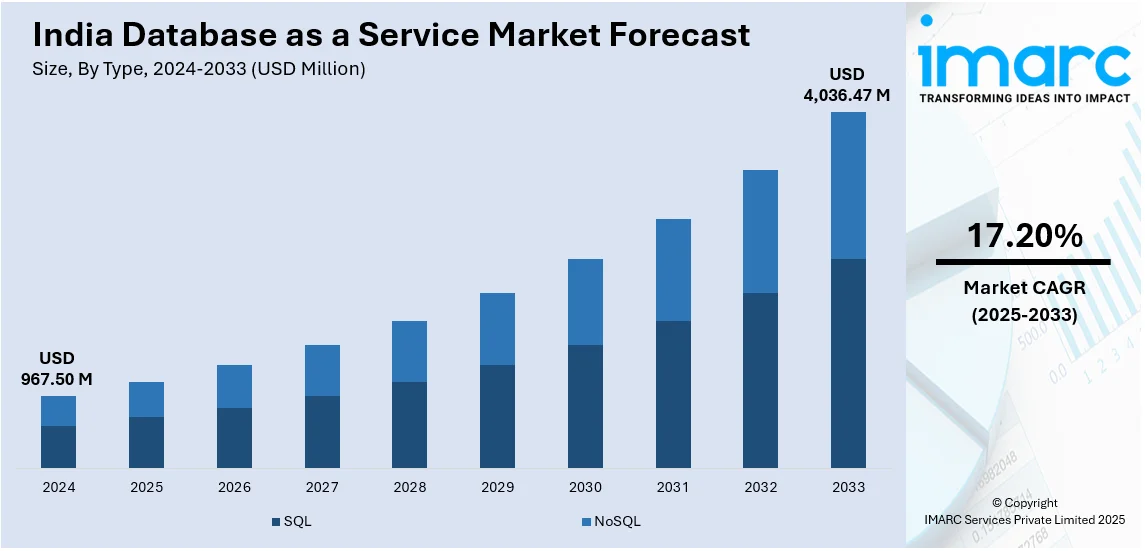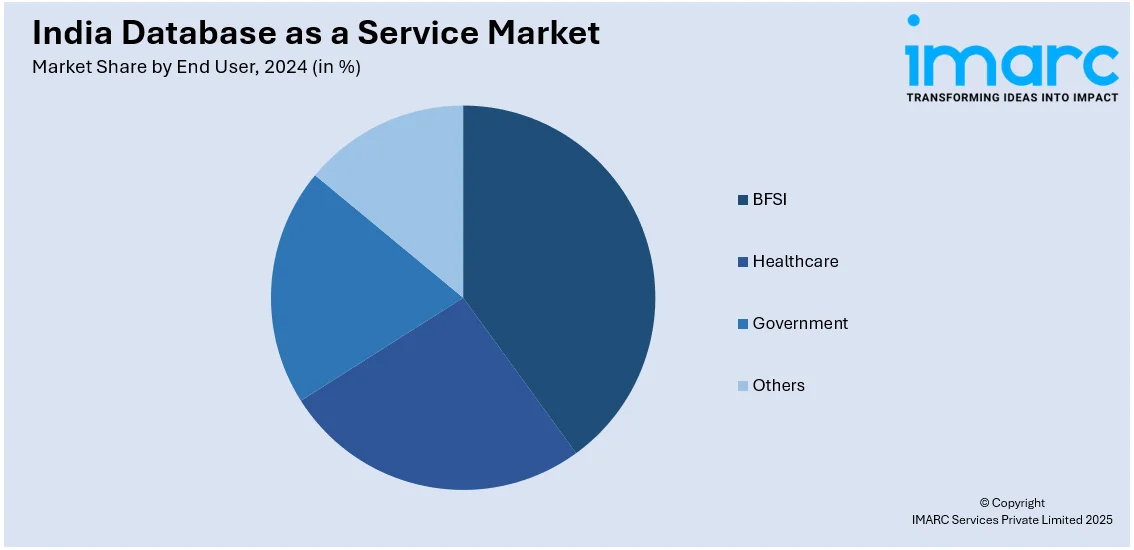
India Database as a Service Market Size, Share, Trends and Forecast by Type, Deployment Type, Organization Size, End User, and Region, 2025-2033
India Database as a Service Market Overview:
The India database as a service market size reached USD 967.50 Million in 2024. Looking forward, IMARC Group expects the market to reach USD 4,036.47 Million by 2033, exhibiting a growth rate (CAGR) of 17.20% during 2025-2033. The increasing cloud adoption, rising demand for scalable and cost-effective database solutions, rapid digital transformation across industries, government initiatives promoting data localization, and the expansion of artificial intelligence (AI), the internet of things (IoT), and big data analytics are some of the major factors positively impacting the India database as a service market share.
|
Report Attribute
|
Key Statistics
|
|---|---|
|
Base Year
|
2024 |
|
Forecast Years
|
2025-2033
|
|
Historical Years
|
2019-2024
|
| Market Size in 2024 | USD 967.50 Million |
| Market Forecast in 2033 | USD 4,036.47 Million |
| Market Growth Rate (2025-2033) | 17.20% |
India Database as a Service Market Trends:
Growth in Cloud-Native Databases and Serverless Computing
The adoption of cloud-native databases is accelerating in India as enterprises seek scalable and cost-effective database solutions. Cloud-native databases eliminate the need for extensive infrastructure investments, enabling businesses to handle structured and unstructured data seamlessly. In line with this trend, cloud service provider Amazon Web Services (AWS) announced on March 3, 2025, its plan to invest approximately USD 8.2 Billion in Maharashtra over the next few years, reinforcing India's expanding cloud ecosystem and supporting the increasing reliance on cloud-based database solutions. The need for high availability, low latency, and real-time processing capabilities drives this shift. Serverless computing is further influencing the India database as a service market outlook. With serverless DBaaS, businesses pay only for the storage and compute resources they use, reducing costs while improving operational agility. The financial services, e-commerce, and healthcare sectors are leading this transition, leveraging cloud-native and serverless databases for data analytics, fraud detection, and customer personalization. As organizations continue migrating from traditional on-premise database systems, DBaaS providers are enhancing their offerings with automated scalability, AI-driven query optimization, and seamless multi-region deployments, making cloud-native databases a dominant trend in the market.

To get more information on this market, Request Sample
Artificial Intelligence (AI) and Machine Learning (ML) Integration for Database Automation
Artificial intelligence (AI) and machine learning (ML) are facilitating the India database as a service market growth by automating database management, query optimization, and predictive analytics. AI-powered databases identify performance bottlenecks, analyze workload patterns and autonomously adjust configurations to enhance efficiency. For example, on May 2, 2024, Oracle announced the general availability of Oracle Database 23ai, a long-term support release featuring over 300 new capabilities, notably AI Vector Search. This functionality enables efficient semantic searches across documents, images, and relational data, allowing integration with private business data without duplication. Machine learning algorithms help in anomaly detection, fraud prevention, and automated indexing, reducing manual database tuning efforts. Enterprises in sectors like retail, telecom, and fintech are leveraging AI-driven DBaaS solutions to gain deeper insights from customer data, optimize marketing campaigns, and improve user experiences. Predictive analytics capabilities in DBaaS are enabling businesses to forecast demand, detect trends, and automate decision-making processes. The rise of AI-enabled DBaaS solutions is also driving innovation in natural language querying, making database interactions more intuitive for non-technical users.
India Database as a Service Market Segmentation:
IMARC Group provides an analysis of the key trends in each segment of the market, along with forecasts at the country level for 2025-2033. Our report has categorized the market based on type, deployment type, organization size, and end user.
Type Insights:
- SQL
- NoSQL
The report has provided a detailed breakup and analysis of the market based on the type. This includes SQL and noSQL.
Deployment Type Insights:
- On-Cloud
- On-Premises
A detailed breakup and analysis of the market based on the deployment type have also been provided in the report. This includes on-cloud and on-premises.
Organization Size Insights:
- Small Enterprises
- Medium Enterprises
- Large Enterprises
The report has provided a detailed breakup and analysis of the market based on the organization size. This includes small enterprises, medium enterprise, and large enterprises.
End User Insights:

- BFSI
- Healthcare
- Government
- Others
A detailed breakup and analysis of the market based on the end user have also been provided in the report. This includes BFSI, healthcare, government, and others.
Regional Insights:
- North India
- South India
- East India
- West India
The report has also provided a comprehensive analysis of all the major regional markets, which include North India, South India, East India, and West India.
Competitive Landscape:
The market research report has also provided a comprehensive analysis of the competitive landscape. Competitive analysis such as market structure, key player positioning, top winning strategies, competitive dashboard, and company evaluation quadrant has been covered in the report. Also, detailed profiles of all major companies have been provided.
India Database as a Service Market News:
- Mar 11, 2025: E2E Cloud has launched its Sovereign Cloud Platform, an AI-powered solution designed to give organizations full control over their digital infrastructure, addressing concerns around data sovereignty, vendor lock-in, and cloud technology sanctions. Sovereign Cloud provides more than 50 cloud services, encompassing Compute, Object Storage, Virtual Private Cloud (VPC), Block Storage, Auto Scaling, Load Balancing, Database as a Service, Function as a Service (FaaS), Parallel File System, and AI/ML functionalities.
India Database as a Service Market Report Coverage:
| Report Features | Details |
|---|---|
| Base Year of the Analysis | 2024 |
| Historical Period | 2019-2024 |
| Forecast Period | 2025-2033 |
| Units | Million USD |
| Scope of the Report |
Exploration of Historical Trends and Market Outlook, Industry Catalysts and Challenges, Segment-Wise Historical and Future Market Assessment:
|
| Types Covered | SQL, NoSQL |
| Deployment Types Covered | On-Clous, On-Premises |
| Organization Sizes Covered | Small Enterprise, Medium Enterprises, Large Enterprises |
| End Users Covered | BFSI, Healthcare, Government, Others |
| Regions Covered | North India, South India, East India, West India |
| Customization Scope | 10% Free Customization |
| Post-Sale Analyst Support | 10-12 Weeks |
| Delivery Format | PDF and Excel through Email (We can also provide the editable version of the report in PPT/Word format on special request) |
Key Benefits for Stakeholders:
- IMARC’s industry report offers a comprehensive quantitative analysis of various market segments, historical and current market trends, market forecasts, and dynamics of the India database as a service market from 2019-2033.
- The research report provides the latest information on the market drivers, challenges, and opportunities in the India database as a service market.
- Porter's five forces analysis assist stakeholders in assessing the impact of new entrants, competitive rivalry, supplier power, buyer power, and the threat of substitution. It helps stakeholders to analyze the level of competition within the India database as a service industry and its attractiveness.
- Competitive landscape allows stakeholders to understand their competitive environment and provides an insight into the current positions of key players in the market.
Key Questions Answered in This Report
The database as a service market in India was valued at USD 967.50 Million in 2024.
The India database as a service market is projected to exhibit a (CAGR) of 17.20% during 2025-2033, reaching a value of USD 4,036.47 Million by 2033.
The market is fueled by cloud adoption, cost savings, and increasing demand for scalable data storage solutions. Managed database services are increasingly being favored by enterprises so that they can concentrate on core activities. Growth in AI, analytics, and digital transformation programs in various industries is driving the adoption of DBaaS. Security, flexibility, and maintainability further add to market growth in India.
Need more help?
- Speak to our experienced analysts for insights on the current market scenarios.
- Include additional segments and countries to customize the report as per your requirement.
- Gain an unparalleled competitive advantage in your domain by understanding how to utilize the report and positively impacting your operations and revenue.
- For further assistance, please connect with our analysts.
 Request Customization
Request Customization
 Speak to an Analyst
Speak to an Analyst
 Request Brochure
Request Brochure
 Inquire Before Buying
Inquire Before Buying




.webp)




.webp)












